June 2011
Again
we can't complain about the number of decks to choose from this month
and the short list has never been that long. Although we had some good
finds at the open air flea market in Utrecht, which was held twice this
month, and brought home some nice decks from the last collectors meeting
before the summer break, again the main source of decks was Ebay.
To
illustrate the tough choice we'll sum up the "short" list: an
antique German deck by the Vereinigte Stralsunder Spielkartenfabriken
from around 1890, a great Pin-Up deck from India from the 1960's, two
beautiful artist decks from the UK, a vintage Belgian Fortune Telling
deck by Van Genechten from 1928 and a Belgian deck with 55 painted
portraits by a small printer from 2008. Although none of these decks
made it to this spot, some were too rare or beautiful to ignore, so
you'll find the Indian Pin-Up deck in our "Pin-Up &
Erotica" xpo and one of the UK artist decks in the "Art &
Cards" xpo.
The chosen one
this month was made in Italy. It's a deck by the Italian comic artist Benito
Jacovitti, who was born in Tremoli on March 19, 1923. He has a special place in
our hearts, ever since we met his work in comic magazines and comics like Cocco
Bill and Zorry Kid in the 1960's. Jacovitti died in 1997.
Because
the text on the cards is in Italian and our knowledge of Italian is
limited, help came from our collector friend from Italy, Gustavo
Orlando-Zon. He translated those captions that we didn't understand and
supplied information about the deck.
|

|
 |
The deck was made by Arti Grafiche Panetto
& Petrelli and published before the municipal elections of 1951 in
Italy. It's obviously an anti-communist edition, which is not a surprise,
as in that period Jacovitti was working for Il Vittorioso, a Catholic
comic magazine for young adults. A reprint of the the original deck
was published around 1975. |
The design of the backs suggests that the deck was published
by an anonymous Civic Committee. As far as we could tell, the text in the outer ring
consists of conjugations of the verb to vote. The inner ring was to difficult for
us and was translated by Gustavo as: "What are you going to
do that day? I'll go and vote. You're in trouble if you don't. Where are you
going in such a hurry? I'm going to vote. You're in trouble if you don't".
In 1951 municipal elections were held in Italy. That same
year the political emotions of that era in Italy were depicted very well in the first
movie in the Don Camillo series, in which Fernandel played the role of a
Catholic priest who was at war with the town's communist mayor. Just like the
movie, this deck uses humor to tackle communism in general and the Italian
communist party (PCI) and their newspaper l'Unita in particular.
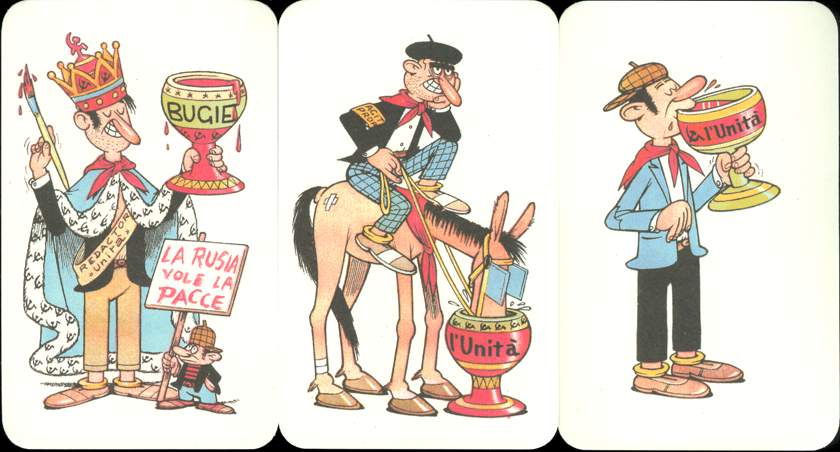
The Cups suit is
apparently dedicated to the pro Russian and pro communism propaganda, as brought
by leftwing newspapers, especially the communist l'Unita newspaper. The Clubs
suit shows the aggressive side of the Italian communist party. Gustavo
pointed out that in fact a lot of Italians were really afraid of the (local)
communists.
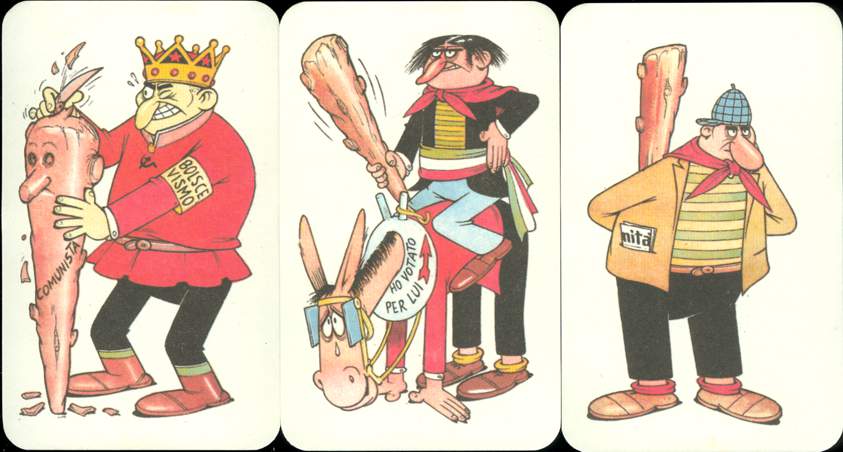
The Italian communists
are mostly depicted with a red scarf around their necks, the Russian ones are
wearing a red coat. The communist mayors can be recognized by the sash in
Italian colours around their waist. No names are mentioned on the cards, but the
only easily recognizable figure is Stalin, who appears on several cards. Thanks
to Gustavo we now know that on the ace of coins Stalin hands the Russian rouble
to Palmiro Togliatti, the leader of the Italian Communist Party between
1927 and 1964. The financial ties between the Russian Communist Party and
Italian parties are emphasized in the coins suit. On the 3 of coins Gustavo
recognized Pietro Nenni, the leader of the Italian Socialist Party.
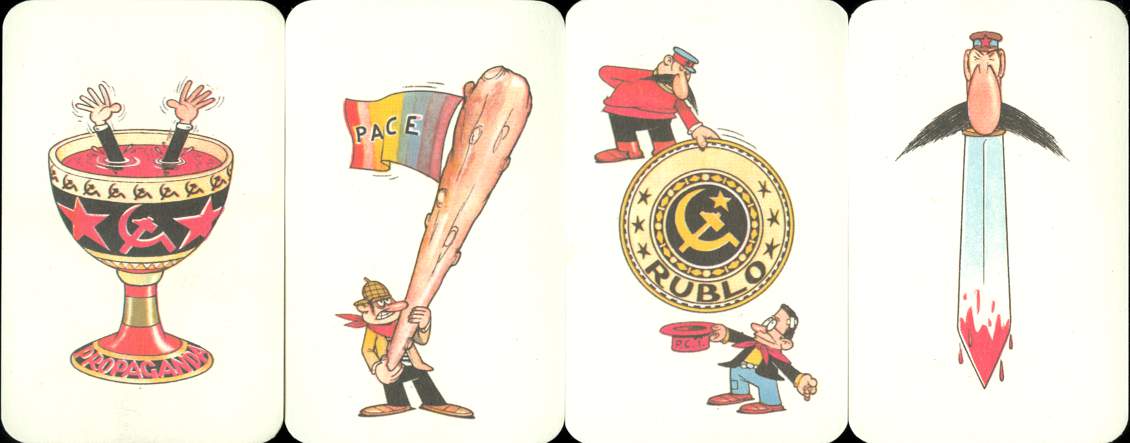
CLICK THE ACE TO
SEE ALL THE PIPS PER SUIT
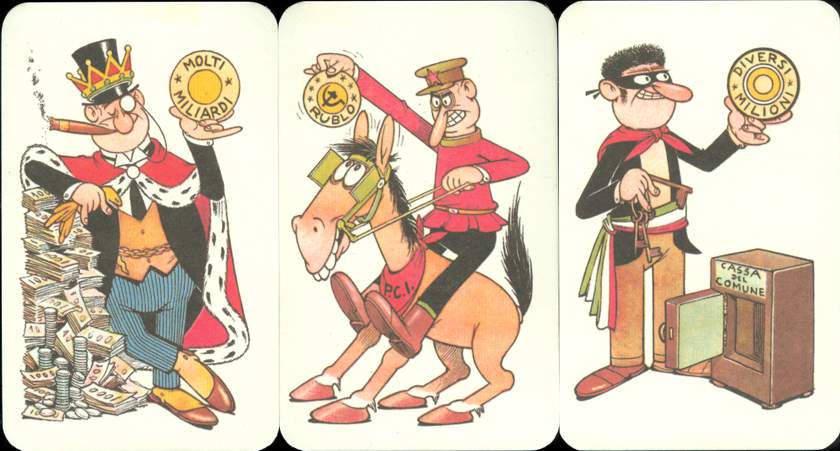
Although the Cups
suit propagates the Russian will for peace, the Swords
suit emphasizes the belligerent face.
Stalin, seated on an Italian communist horse, has killed the peace dove.
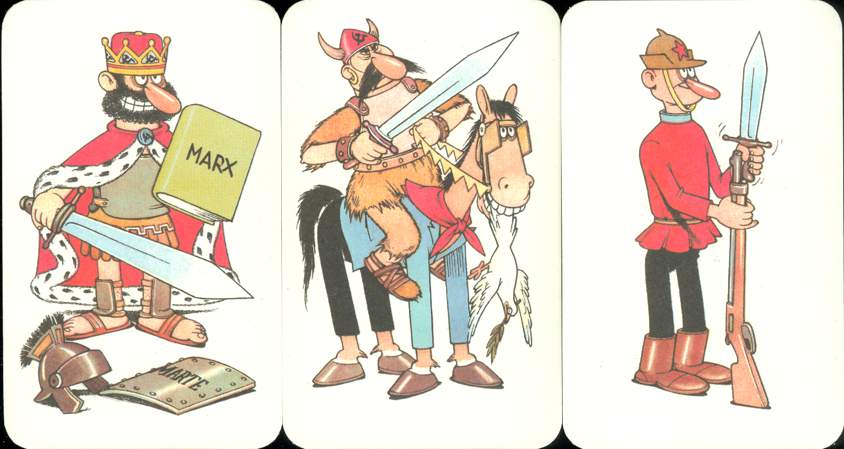
The deck consists
of 40 cards, not an unusual number for Italian decks. They are somewhat larger
than usual and measure 71 by 113 mm. As the cards from the original deck seem to
measure
72 by 114 mm, we assumed that our deck was the reprint from 1975. But in March
2012, we heard from Gustavo again and he told us that the reprint from 1975 has
square corners. So this is the original deck! The cards are printed on very thin carton, which lets the back design shine through when held to
the light. The deck was never issued with a box, but in 2007
PubbliCartoMania published a box for this deck in honour of Jacovitti.
There's another
deck by Jacovitti in our collection and it's shown in the "Pin-UP &
Erotica" Xpo.
Interested? It's only a CLICK
away!
BACK TO PRESENT MONTH






